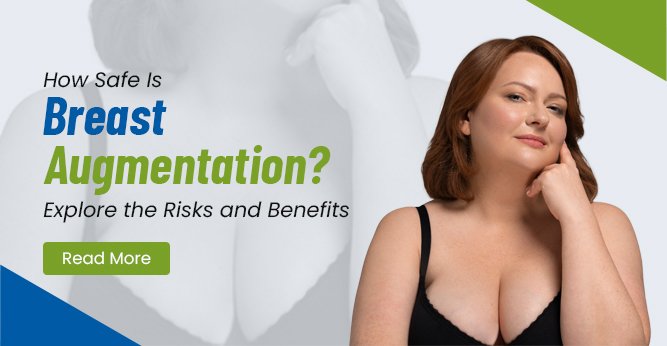Breast augmentation, also known as augmentation mammoplasty, is a popular cosmetic procedure designed to enhance breast size and shape. Whether for aesthetic or reconstructive purposes, it’s crucial to understand the details, benefits, and potential risks before opting for the surgery. In this blog post, we will share detailed insights into everything you need to know about breast augmentation surgery, from the various types of procedures to the recovery process and safety concerns, to help you make an informed decision.
What Is Breast Augmentation Surgery?
Breast augmentation involves using implants or fat transfer to increase breast size, restore breast volume lost due to factors such as weight loss or pregnancy, or improve natural breast asymmetry. It’s sometimes referred to as a “boob job” in colloquial terms and is performed to achieve various goals, including enhancing body proportions, boosting self-esteem, or reconstructing the breast following a mastectomy.
There are different types of breast augmentation procedures based on the material used for enlargement:
- Silicone Implants: Silicone implants are filled with a gel that closely mimics the texture of natural breast tissue, making them a popular choice for those looking for a more natural feel. However, routine monitoring is recommended to detect any possible rupture since leaks may not always be obvious.
- Saline Implants: These implants are filled with sterile salt water and are inserted empty before being filled during the surgery. Saline implants offer a uniform shape and firmness and are a safer option in case of rupture, as the body easily absorbs the saline solution.
- Fat Transfer: Fat transfer, or autologous breast augmentation, involves liposuction to extract fat from other areas of the body, which is then purified and injected into the breasts. This option is less invasive than implants, but it may not result in as dramatic an increase in breast size.
Who Is a Good Candidate?
Breast augmentation is suitable for individuals who have fully developed breasts and are seeking to:
- Increase breast size for a more balanced look.
- Restore volume lost after significant weight loss, pregnancy, or breastfeeding.
- Correct asymmetrical breasts.
- Address underdeveloped breast tissue.
However, it’s essential for prospective candidates to have realistic expectations and be in good overall health. Before considering the surgery, thorough discussions with a qualified surgeon can help determine if breast augmentation is right for you.
Benefits of Breast Augmentation

- Enhanced Aesthetic Appearance: Breast augmentation can significantly improve body proportions, giving individuals a more balanced silhouette.
- Boosted Self-Confidence: For many, enhancing breast size and shape can lead to increased self-esteem and body image satisfaction.
- Restored Volume and Shape: Women who have experienced volume loss due to weight fluctuations, pregnancy, or aging can restore their natural curves.
- Correction of Asymmetry: Breast implants can correct uneven breast sizes, helping to achieve a more symmetrical appearance.
- Reconstructive Benefits: After a mastectomy, breast augmentation can help rebuild the breast’s shape and restore a sense of normalcy.
What are the Risks of Breast Augmentation?
While breast augmentation is generally considered safe, it’s not without risks. Complications can vary based on the type of implant and the individual’s health. Some common risks include:
Common Risks
- Infection: Like any surgery, infection is a risk, especially if post-operative care isn’t followed correctly.
- Implant Rupture or Leakage: Saline ruptures are immediately noticeable, while silicone leaks may require an MRI or ultrasound to detect.
- Changes in Nipple or Breast Sensation: Some patients report altered sensations, which can be temporary or permanent.
- Capsular Contracture: This occurs when scar tissue around the implant tightens, distorting the shape of the breast.
- Persistent Pain: Post-surgery discomfort can sometimes extend beyond the typical recovery period.
Rare Complications
- Breast Implant-Associated Anaplastic Large Cell Lymphoma (BIA-ALCL): A rare form of lymphoma linked to textured implants.
- Breast Implant-Associated Squamous Cell Carcinoma (BIA-SCC): Another rare cancer that can develop in the capsule around the implant.
- Systemic Symptoms (Breast Implant Illness): Some women report symptoms like fatigue, “brain fog,” and joint pain, which may be linked to the presence of implants.
How Safe is Breast Augmentation?
Breast implants undergo rigorous testing and must be approved by the FDA to ensure their safety and effectiveness. Silicone and saline implants have both been deemed safe for use. However, regular monitoring is crucial, particularly with silicone implants, to detect any silent ruptures. It’s also worth noting that implants are not designed to last a lifetime. Many women will require revision surgery at some point, either to replace aging implants or address complications.
If any complication arises, or if a patient decides to have the implants removed, consulting with a board-certified plastic surgeon is imperative.
Understanding Implant Displacement and Rupture
-
Implant Displacement
Implant displacement, or implant malposition, can occur if the implants are not properly placed during surgery or move out of position over time. This can result in asymmetry or an unnatural appearance. A highly skilled surgeon will minimize this risk by carefully creating the breast implant pocket and choosing the right size implant.
-
Implant Rupture
Implant ruptures, though rare, can happen. Saline ruptures are immediately visible, as the implant deflates. Silicone ruptures, on the other hand, are known as “silent ruptures” because the cohesive gel doesn’t leak out, making them harder to detect. Routine imaging tests are recommended for silicone implant users to check for ruptures.
It’s crucial to choose a board-certified plastic surgeon with extensive experience in breast augmentation to ensure the best possible outcome.
Recovery and Aftercare
Recovery times for breast augmentation vary, but most patients can return to light activities within a week. Full recovery, however, can take several months. Here’s what to expect during the healing process:
-
Short-Term Recovery
During the first few days, swelling and discomfort are common. Pain medications will be prescribed to manage any discomfort. It’s important to keep incision sites clean and dry to prevent infection.
-
Long-Term Recovery
Swelling and soreness can last several weeks, and it may take up to six months for the breasts to settle into their final shape. Follow-up appointments are essential to monitor progress and address any concerns.
Setting Realistic Expectations
Having realistic expectations is key to satisfaction with your breast augmentation results. Looking at before-and-after photos of patients with similar body types can help you gauge potential outcomes. While breast augmentation can enhance your appearance, it won’t necessarily solve body image issues or make you feel completely different overnight. Understanding the limitations and possibilities of the surgery is crucial.
How to Find a Cosmetic Surgeon for Breast Augmentation
The most important decision you’ll make regarding breast augmentation is choosing a qualified surgeon. Here’s what to consider:
- Board Certification: Ensure your surgeon is certified by a recognized board.
- Experience: Choose a surgeon with extensive experience in breast augmentation and breast implant procedures.
- Patient Reviews and Before-and-After Photos: Review past patient testimonials and photos to evaluate the surgeon’s work.
- Comfort and Communication: A good surgeon should listen to your goals and answer all your questions honestly.
When it comes to breast augmentation or any other cosmetic procedure, only the best will do. At Celebre Aesthetics in Surat, we are committed to delivering exceptional results with a focus on safety and patient satisfaction. Led by Dr. Sidharth Sakhiya, a board-certified surgeon with over 10 years of experience, we combine expertise, advanced techniques, and a patient-centric approach to provide the highest standard of cosmetic care.
Our facility is equipped with world-class equipment and staffed by a highly qualified team dedicated to offering 24/7 support. From the initial consultation to post-operative care, we prioritize your comfort and safety at every step of breast augmentation surgery. Contact us to schedule an appointment now!
The Bottom Line
Breast augmentation can be a life-changing procedure for many women, enhancing both appearance and self-confidence. While the surgery has risks, choosing a skilled surgeon and following proper aftercare guidelines can minimize complications. Always ensure you’re well-informed and consult with a board-certified plastic surgeon to discuss your goals, expectations, and any concerns you might have before making a decision.




